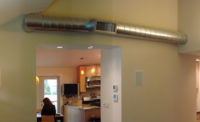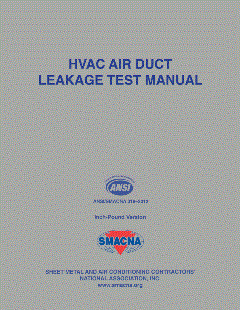When contractors discuss air ducts with customers, they often explain it in simple terms they’re likely to understand: Ducts are the home’s arteries and veins, and the furnace or a/c unit is the system’s heart. Air is circulated throughout the home, whooshing through the supply and return ducts, much like blood is pushed through the arteries and veins of the body, always traveling back to the heart to begin the journey again.
And, just as an infection can spread from one part of the body to another, so can contaminated air, which is why an increasing number of home and building owners are choosing to install ultraviolet (UV) products that improve IAQ by cutting down on the spread of allergens, mold, volatile organic compounds (VOCs), bacteria, viruses, and more.
Why UV?
Forrest Fencl, an ASHRAE fellow and president of UV Resources, said the UV-C waveform, which kills microorganisms of all kinds, was first utilized in the 1950s, when Tuberculosis outbreaks “were on the rise in the U.S., and the many antibiotic cocktails we have today were simply not available.”
Since UV-C had been shown to greatly reduce incidents of Tuberculosis, “hospitals have incorporated UV-C in various air conveyance systems, and, after incorporating UV-C, the incidences of Tb were greatly reduced,” Fencl said. “In the 1960s, hospitals began using isolation rooms to contain any infectious agents a patient may have. UV-C, along with HEPA filtration, was used in these applications within the recirculating ductwork as well as in self-contained recirculation systems, where single-pass kill ratio of infectious agents was 99.9 percent or greater.”
Fencl continued: “Notable UV-C applications include the Pentagon, for protection against bio-terrorism agents; the CDC [Centers for Disease Control and Prevention], for protection against catastrophic spillages of infectious agents; and the isolation units at Emory University hospital, where the now-famous Dr. Kent Brantly and Nancy Writebol, who both were infected
with Ebola, were taken to recover. These are only some of the uses of UV-C in ductwork, and the goals are similar — they’re used to increase yield and shelf life, to reduce costs and manufacturing time, and to protect humans.”
Emily Zimmerman, product manager, air handlers and coils, Johnson Controls Inc., unitary products group, said adding UV to an existing system has numerous benefits. “Multiple studies show the lamp reduces airborne disease transmission,” she said. “The result, particularly in commercial and institutional applications, is improved productivity and reduced absenteeism for people living or working in the building.”
Kevin Lyons, IAQ product manager, Lennox Residential, said, if they are installed in the correct location and are sufficiently powerful, UV lamps inhibit fungal and bacterial growth and contribute to improved IAQ. “Odors can often be traced to microbial growth,” he added.
Chris Willette, president, Fresh-Aire UV, agreed the technology immediately reduces odors and allergens, and, over a period of time, reduces mold and a/c coil foiling.
“The immediate benefit is better air quality,” agreed Aaron Engel, vice president of marketing and communications, Sanuvox Technologies Inc. “As the HVAC system circulates the air within the building’s envelope, the concentration of contaminants continually builds. … By incorporating UV systems into the ductwork, we are bringing the same natural process that cleans our atmosphere into the building. The UV systems complement the system’s filtration; where the filter will capture larger particulates, such as dust and dirt, the UV system will address the other contaminants that pass through.”
Overall, UV-C can be a good and often inexpensive option for customers looking to improve their home or building’s IAQ.
“The air in the home will be cleaner and the health of the occupants improved,” said Bobby Nelson, vice president of sales and marketing, Field Controls LLC. “The UV will prevent the growth of mold and mildew on the A-coil; therefore, the system will run more efficiently, and the coil will last longer.”
A Growing Market
The UV market has experienced growth in recent years, which is largely due to technological advancements as well as shrinking costs.
“A combination of higher awareness of IAQ issues and more powerful lamps that are more effective is contributing to more frequent installations,” Lyons added.
“It’s easier to size, obtain, and install UV-C for any contractor who wants to offer it,” Fencl said. “UV-C today is at least 40 percent less expensive than it was just eight years ago. Both of these changes are indicative of the market’s direction toward increased use of retrofits, where millions of AHUs [air-handling units] and air conveyance systems are not yet equipped with UV-C.”
While the residential market was first to embrace UV technology, the commercial market is quickly catching up. “It is virtually 50/50 [commercial and residential],” Engel said. “For more than 20 years, homeowners have benefitted from UV systems installed on their evaporator coils as well as in their ductwork. Commercial applications have really gained in popularity within the last 10 years. A large part of this can be attributed to UV being introduced into the ASHRAE Handbook in 2008.”
“The residential market has the highest sales volume,” Willette added. “However, the commercial market is beginning to realize the benefits of UV. Energy savings are more readily realized in commercial applications versus residential installations.”
Zimmerman said installers are showing a growing interest in residential UV lights, “although we are seeing actual applications in that market decrease.” She added, “It’s a little easier to make the case for UV commercially, especially where funding can be tied to improved productivity and reduced absenteeism.”
Nelson said UV is being installed more often in residences, in his experience, though they are seeing “more and more commercial applications for purification technology.” He also stressed the importance of selecting the right product for the job.
“The area where we see growth is in the application of photocatalytic oxidation [PCO] combined with UV in commercial applications,” he said. “We have installations where our PRO-Cell™ Technology has been selected by commercial clients in hospitals, labs, casinos, and airports, diminishing and eliminating smoke, odors, and VOCs. Many of these markets have applications and environments where the effective control of these IAQ issues is critical to their customers, profit, or building efficiency including the health of the occupants.”
What’s Next for UV
With technology improving and costs coming down, industry leaders anticipate UV applications will continue to grow across both the residential and commercial markets.
“Increased demand for UV lights has followed the population growth in the South, thus driving sales to existing homeowners as well as to new homeowners who want to easily and quickly improve IAQ in the home with an inexpensive retrofit,” Lyons said.
Engel also acknowledged a growing UV supply and demand. “Two decades ago, there may have been six companies manufacturing UV systems for HVAC applications. Today, there are dozens,” he said. “Although UV for HVAC has increased in popularity, it is still very much in its infancy with a fraction of homes and buildings using the technology. With increased awareness and the advantages of the technology being promoted by the engineering and HVAC community, there will be an even wider acceptance to the point where UV will become mainstream.”
Nelson agreed that UV growth goes hand-in-hand with the elevated awareness of IAQ.
“The applications, acceptance, and performance of UV technologies and products are definitely growing,” Nelson said. “Additionally, PCO technologies, which are relatively new to residential and commercial applications and markets, will also grow. Demand is going up as homeowners, facility managers, and contractors become better educated about the benefits of UV and PCO. Over the next several years, PCO technology will lead in the purification markets as more and more applications require odor control and elimination of VOCs.”
Zimmerman said more and more customers are combining UV products with other IAQ technologies, including filters and PCO. “Many of the combination devices, however, move in the wrong direction from a cost perspective.”
Also driving growth in the market is the HVAC industry’s growing acceptance of the technology.
“UV technology has been gaining credibility and has been recognized by ASHRAE with upcoming standards such as SPC185.1 and SPC185.2,” Willette said. “The UV market has been on a nice market growth curve.”
Advice for Contractors
As products continue to improve, UV manufacturers are encouraging contractors to incorporate the technology into their offerings.
“Our advice to contractors would be to align themselves with a major manufacturer who offers advice, sizing tools, and online and live support. This will allow them to address any and all opportunities they are exposed to,” Fencl said. “It’s a needed and growing market must-have that builds goodwill and profitable relationships with customers.”
“Do your research and contact a few companies that offer purification technologies,” Nelson said. “Ask them what the product does and why. Ultimately, you want to provide a safe product that does the job and extends value to your customer. Remember, the industry and these products have yet to be regulated, so find an honest, reputable OEM that is willing to sit down and explain the basics and train you — preferably one with a NATE [North American Technician Excellence]-recognized module on UV.
“Adding purification technologies to your portfolio is a great way to boost revenue stream and secure repeat business,” he continued. “Bulbs need to be replaced on a regular schedule, and it gets you in the home. And, most importantly, if you get the right products, you will solve homeowners’ problems, which makes you a partner and not just a contractor. Homeowners want IAQ solutions and are willing to pay to solve their problems.”
Engel agreed it is important to understand the technology and pair the application with the correct UV product. “If a customer is looking to treat the air within the home or building’s envelope, do not promote a UV light for the coil, and the same is true for coil cleaning. A UV system is not a silver bullet; it is but one more tool at the contractor’s disposal that should be used to better the air quality, improve equipment efficiency, and ultimately make the home or workplace environment safer and more comfortable.”
Willette said adding UV or PCO “is a great tool for increasing sales and product diversity.” And, like Fencl, he also recommends “getting training by the equipment manufacturer or its manufacturer representatives.”
Lyons urged contractors to explore a wide variety of UV lamp applications, including those outside of ductwork. “Many geographies have seasonal high humidity outside of stereotypical humid areas like the Gulf Coast and Southeast. Contractors should also be skeptical of UV products that claim to be able to kill on the fly; little evidence exists to support such aggressive marketing claims.”
In the end, Zimmerman said it’s most important for contractors to know the technology and make sure they’re pairing the right products with the applications.
“Contractors need to make sure they are buying a product that has the intensity to do what it’s supposed to do. They also need to pay attention to lamp replacement, either with an annual maintenance agreement with the homeowner or by some other reminder,” she said.
“Some thermostats we sell have a built-in UV replacement timer, so there is a notice to the homeowner that the emitter needs to be replaced. If it’s not being replaced, after a year’s time, the homeowner is not getting the benefit of the UV light, and the mold and bacteria will begin to grow, despite the glowing blue light. In summary, contractors need to pay attention to the quality of the product they’re installing and make sure the lamp is being replaced in a timely manner.”
Publication date: 10/20/2014
Want more HVAC industry news and information? Join The NEWS on Facebook, Twitter, and LinkedIn today!





![â??Adding an IAQ product such as UV or PCO [photocatalytic oxidization] is a great tool for increased sales and product diversity,â?? Willette said. (Photo courtesy of Fresh-Aire UV)](https://www.achrnews.com/ext/resources/2014/10-2014/10-20-2014/S-Fresh-AireUV2.jpg?t=1413782506&width=1080)









